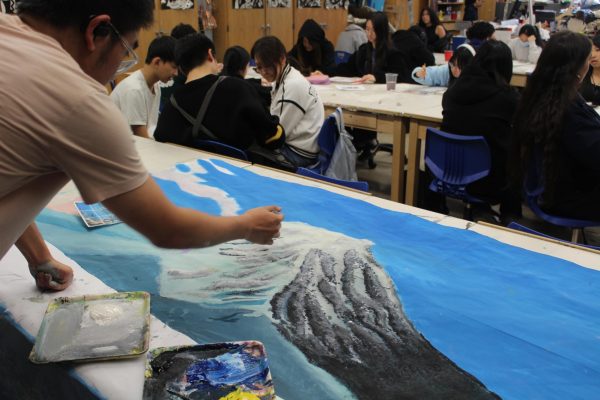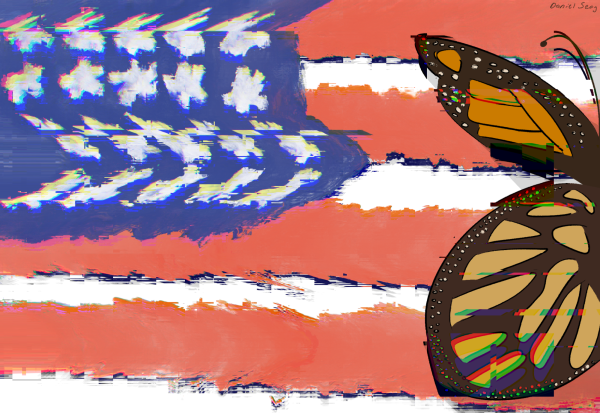ASL Club Brings Awareness to Deaf Culture
Silence fills the classroom as students mirror the teacher’s hand motions. They sign the question “Do you like ice cream?” They alter their physical movements by raising an eyebrow and leaning forward. Rows of students are instructed to pair up and sign with each other. After regrouping, students clearly understand what each sign means due to repetition. This is what a regular Friday afternoon looks like in room 324, or American Sign Language Club.
“Our club and board members have implemented a teaching method for American Sign Language that involves PowerPoint or slideshow presentations on specific topics,” ASL Club President Donald Tang said. “We aim to provide members with the necessary vocabulary and signs they would use in conversations, incorporating reviews and repetition to ensure a thorough understanding of each sign.
“We encourage members to engage with each other through short turn-and-talk activities and conclude each lesson by translating example questions into ASL format, signing them either individually or as a group,” Tang added. “Additionally, we encourage members to ask questions about new signs that may arise outside of the lesson but are still relevant to the topic at hand.”
The dedication that the senior-consisting board of the club has in teaching ASL has inspired many students to put in the same amount of effort in learning it as well.
“I am extremely committed to the club and learning ASL,” sophomore and ASL Club member Tyler Tang said. “I try to never miss a meet due to the club having good vibes, the board is friendly, and overall learning ASL is interesting.”
American Sign Language differs from other languages taught in American schools and alters the mindset of individuals as well. Data gathered by UC Davis and California State University concluded that teaching sign language to babies increased their reasoning skills and IQ by approximately 122 points.
“First, I think that you have a kinesthetic value there, so students are moving their hands, it is a whole different way of learning,” AP of World Languages Ms. Irving said. “I think that is very fitting for both interest and let’s say natural inclination. Not everyone has strong verbal skills, but they have other skills that would benefit from being in an ASL class. I’m not great with my hands, I can’t tell you that. I’m lucky I can put anything together in an organized fashion.”
Furthermore, learning ASL has a great number of benefits, one of which can be expanding one’s mindset and exposing themselves to associating with different parts of the population. According to the National Center for Health Statistics, there are approximately 37 million deaf and hard of hearing people living in the United States.”There’s a quite large need for representation for the deaf culture,” according to Donald Tang.
“When you are learning ASL, that’s what you would be doing and that type of communication is so fascinating and really opens the door for communication with another population,” Ms. Irving said. “There’s a very large population that uses American Sign Language in the world. So, having that ability as a student learning over time gives you a different perspective and also gives you a true ability to reach other portions of the population.”
As great as learning and teaching ASL at FLHS may be, there isn’t an official language course dedicated to ASL yet.
“The sports medicine program, the only way you could learn American Sign Language within the school is through that program,” Donald Tang said. “At the end of the curriculum, towards your second year. All we did was learn the alphabet and numbers 1 through 10. I wanted to essentially teach sign language more in-depth and started a club just out of fun. So not only me, but everyone else can start learning as well.”
As said by Cynthia Wu, sophomore and ASL club member, this particular language would be hard to test, as it’s not written like other languages that Francis Lewis offers.
“I’m not sure how to explain this but I think testing it would be hard, especially since there is a LOTE exam. I’m also not sure how it would be imputed into a standardized test in a classroom, but it could be possible in the future though,” Wu said.
However, the real reason why Francis Lewis High School doesn’t have an official ASL class is because there aren’t many certified teachers, according to Ms. Irving.
“I would love to have American Sign Language, I’ve tried for many years to get American Sign Language,” Ms. Irving said. “It’s difficult to find someone qualified to teach it. Certification, a certified teacher is really, really difficult to find. We have one teacher who is able to teach one of our classes. We’ve had a very wonderful experience, but she serves in a compensatory time position, so the amount of classes that she teaches is limited based on that. But I’m always looking for someone who could teach American Sign Language to all of our students.”
Despite not having ASL as an official class, many students are still working hard in the ASL club to learn ASL. Through learning ASL they are able to find a new hobby as well as be able to communicate with more people.
“I just know it’s unique and confusing but fun to learn because you don’t need to speak,” Jiang said. “It’s like dancing with your hands instead of singing with them, or exercising with them.”







